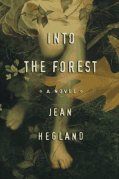 Into the Forest, Jean Hegland (1996)
Into the Forest, Jean Hegland (1996)
Review by Shannon Turlington
“People have been around for at least 100,000 years. And how long have we had electricity?”
“Well, Edison invented the incandescent lamp in 1879.”
“See? All this,” and she swung her arm to encircle the rooms of the only house I’d ever know, “was only a fugue state.” She pointed to the blackness framed by the open door. “Our real lives are out there.”
Two teenage daughters become stranded in their rural California home at the edge of a large, wild forest after the unexplained collapse of society and the accidental death of their father; gradually, the girls accept the reality of their situation and learn how to survive off the forest, which is the only resource they have in abundance.
This book revealed itself slowly, and it took me quite a while to really understand what it was all about. Once it did, everything clicked into place for me. Events that before seemed quite unbelievable became meaningful and even beautiful. The ending left with me with a sense of rightness, as well as melancholy, a tone that completely suited this story.
What I did not understand at first is how much of a feminist text this is. The story is not about the apocalypse so much as it is about women returning to their natural mother, the Earth, and relearning how to live in harmony with nature. The bear is an important symbol who teaches the narrator, Nell, that the forest is not threatening but can be nurturing, life-sustaining and protective.
The strong feminism of this book may turn off some readers. The three male characters all come across as inadequate, and finally the girls realize that they only need one another to survive. I was worried that there would be too much violence against women, but the novel avoids the needless wallowing in violence that most apocalyptic books depict, and the one violent incident that does occur is critical for the story.
The ending of the novel was the most beautiful section for me, as it expresses both a sense of loss and optimism. Nell’s elegy for books as she decides which ones she absolutely needs moved me. I’m not sure I completely agree with the underlying premise that returning to a pre-industrial way of life is the best path, which seems a bit simplistic. We have spent thousands of years constructing a civilization that offers our species a lot of advantages, and I don’t think we will turn our backs on it so easily. I also think that the root of our modern problems also offers our hope for salvation — that is, our ability to understand the world with science and develop new technologies to meet our needs. Perhaps the true answer is an amalgam of the two: looking back to nature for inspiration for technologies that will sustain us as a civilization but won’t eventually destroy us or get used up.
This novel reminded me a lot of another post-apocalyptic novel set in California: Always Coming Home by Ursula K Le Guin. The two books share a feminist context and the theme of remembering how to live harmoniously with nature. Indeed, the people of Always Coming Home could be the far-future descendants of Eva and Nell.
This review originally appeared on Books Worth Reading.

Reblogged this on Shannon Turlington and commented:
My review of the apocalyptic novel Into the Forest by Jean Hegland, posted on SF Mistressworks.